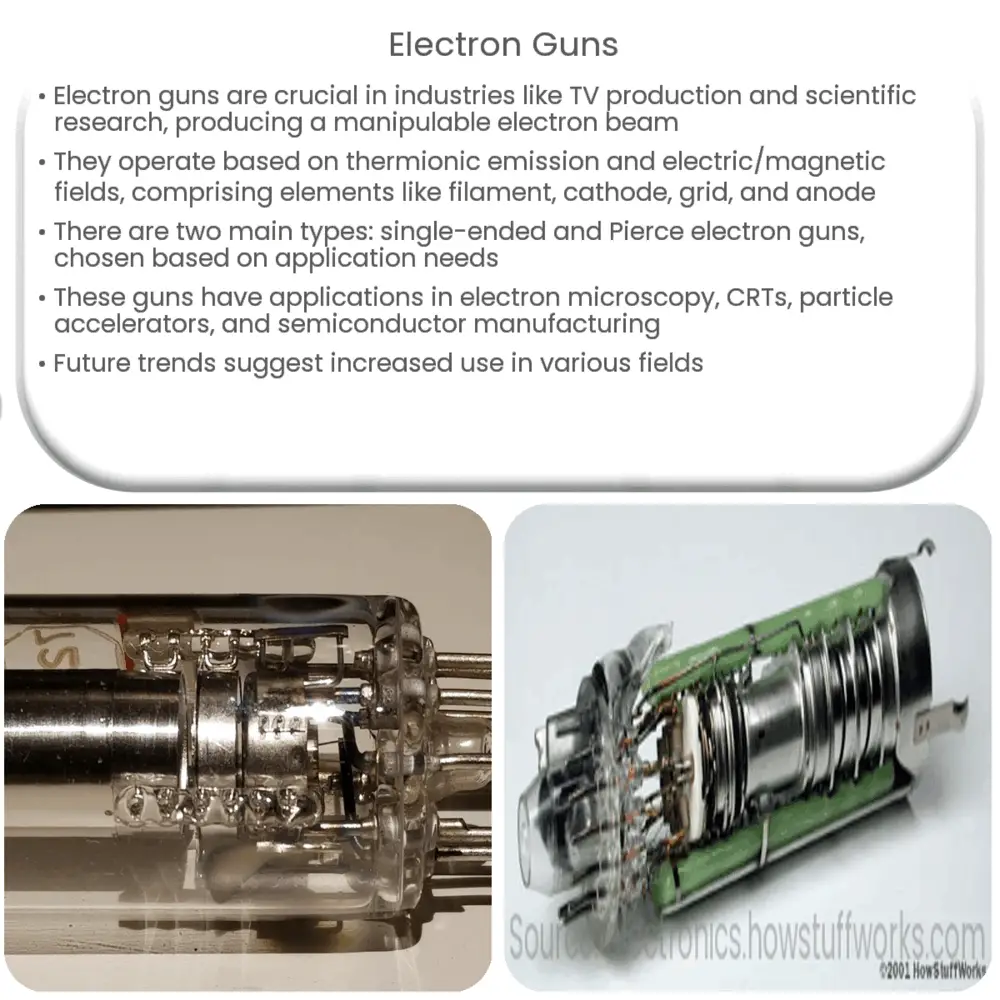Explore the workings of electron guns, their types, applications in various industries, future trends, and their profound impact on technology.

Introduction to Electron Guns
An electron gun is an important piece of technology with wide applications in various industries, including television production, computer monitors, and scientific research. This component is responsible for generating a stream or ‘beam’ of electrons, which can then be manipulated and used for various purposes.
Principle of Operation
The operation of an electron gun is primarily based on the principle of thermionic emission and the properties of electric and magnetic fields. The main elements that contribute to the functionality of an electron gun include a filament, cathode, grid, anode, and electron beam.
- Filament: The filament is a heating element made of tungsten wire. When heated, it emits electrons through thermionic emission.
- Cathode: The cathode, which is part of the filament, is the actual source of electrons. The emitted electrons form a cloud, often referred to as a ‘space charge.’
- Grid: This is a hollow metal cylinder located between the cathode and the anode. It regulates the flow of electrons through the application of a negative potential.
- Anode: The anode accelerates the electrons towards the screen after they pass through the grid. It is set to a high positive potential.
- Electron Beam: The beam is formed as a result of the acceleration of electrons by the anode. It can be manipulated by external electric and magnetic fields.
Types of Electron Guns
There are several types of electron guns, each with unique characteristics and uses. These are broadly classified into two: single-ended electron guns and Pierce electron guns.
- Single-Ended Electron Guns: These are the simplest type of electron gun, often used in oscilloscopes and older CRT monitors. They use a single electrical potential to accelerate the electrons and generate the beam.
- Pierce Electron Guns: Named after its inventor, John R. Pierce, these guns are more complex and are used in applications that require a high-quality, focused electron beam, such as electron microscopes and modern CRT displays.
The choice of electron gun depends on the requirements of the application, with considerations for factors such as the desired beam intensity, focus, and stability.
The development and advances in electron gun technology have played a significant role in shaping numerous fields and will undoubtedly continue to do so in the future. In the next section, we will delve into the applications and the future trends of electron gun technology.
Applications of Electron Guns
Electron guns have wide-ranging applications across various industries and scientific research fields. Some of the notable applications include:
- Electron Microscopy: High-quality, focused electron beams generated by Pierce electron guns are used in electron microscopes to study the structure and composition of materials at the atomic level.
- Cathode Ray Tubes (CRTs): Electron guns are integral components in CRTs found in old television sets and computer monitors, where they generate the electron beam that lights up the phosphor coating on the screen to create images.
- Particle Accelerators: In this application, electron guns generate high-energy electron beams used in various research applications, including particle physics and nuclear physics.
- Semiconductor Manufacturing: Electron beams from electron guns are used in semiconductor manufacturing processes like lithography and inspection.
Future Trends of Electron Gun Technology
As we advance into the future, electron gun technology is expected to play a significant role in emerging fields. High-performance electron guns are being developed to support research in particle physics and to drive the innovation of advanced microscopes for biomedical and materials science research. Also, electron beam technology is increasingly being used in manufacturing, sterilization, and waste treatment processes.
Conclusion
In conclusion, electron guns, as a fundamental piece of technology, have shaped and continue to shape numerous aspects of our daily life and scientific endeavors. From televisions and computer monitors to advanced microscopy, semiconductor manufacturing, and even the exploration of the basic building blocks of the universe, the impact of this technology is broad and profound.
As we look to the future, it is clear that the role of electron guns and the potential of electron beam technology will only continue to grow. This drives the need for continued research and development in this area, pushing the boundaries of what is possible and paving the way for new discoveries and advancements.

